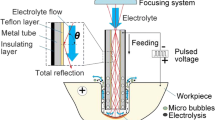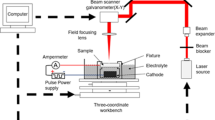Abstract
Laser beam micromachining (LBMM) and micro electro-discharge machining (μEDM) based sequential micromachining technique, LBMM-μEDM, has drawn significant research attention to utilize the advantages of both methods, i.e., LBMM and μEDM. In this process, a pilot hole is machined by the LBMM, and subsequently finishing operation of the hole is carried out by the μEDM. This paper presents an experimental investigation on the stainless steel (type SS304) to observe the effects of laser input parameters (namely, laser power, scanning speed, and pulse frequency) on the performance of the finishing technique, that is, the μEDM in this case. The scope of the work is limited to 1-D machining, i.e., drilling microholes. It was found that laser input parameters mainly scanning speed and power influenced the output performance of μEDM significantly. Our study suggests that if an increased scanning speed at a lower laser power is used for the pilot hole drilling by the LBMM process, it could result in significantly slower μEDM machining time. On the contrary, if the higher laser power is used with even the highest scanning speed for the pilot hole drilling, then μEDM processing time was faster than the previous case. Similarly, μEDM time was also quicker for LBMMed pilot holes machined at low laser power and slow scanning speed. Our study confirms that LBMM-μEDM-based sequential machining technique reduces the machining time, tool wear, and instability (in terms of short circuit count) by a margin of 2.5 x, 9 x, and 40 x, respectively, in contrast to the pure μEDM process without compromising the quality of the holes.




















Similar content being viewed by others
Availability of data and materials
Not applicable
References
Chavoshi SZ, Luo X (2015) Hybrid micro-machining processes: a review. Precis Eng 41:1–23. https://doi.org/10.1016/j.precisioneng.2015.03.001
Rahman M, Asad ABMA, Masaki T, Saleh T, Wong YS, Kumar AS (2010) A multiprocess machine tool for compound micromachining. Int J Mach Tools Manuf 50:344–356
Liu Y, Zhu D, Zeng Y, Yu H (2011) Development of microelectrodes for electrochemical micromachining. Int J Adv Manuf Technol 55:195–203. https://doi.org/10.1007/s00170-010-3035-2
Mishra S, Yadava V (2015) Laser beam micromachining (LBMM) - A review. Opt Lasers Eng 73:89–122. https://doi.org/10.1016/j.optlaseng.2015.03.017
Ghosal A, Manna A, Lall AK (2014) Modelling of ytterbium fiber laser parameters during micro machining of Al-15 wt%Al2O3-MMC. Procedia Eng 90:704–709. https://doi.org/10.1016/j.proeng.2014.11.799
Ancona A, Döring S, Jauregui C, Röser F, Limpert J, Nolte S, Tünnermann A (2009) Femtosecond and picosecond laser drilling of metals at high repetition rates and average powers. Opt Lett 34:3304–3306. https://doi.org/10.1364/ol.34.003304
Gruner A, Schille J, Loeschner U (2016) Experimental study on micro hole drilling using ultrashort pulse laser radiation. Phys Procedia 83:157–166. https://doi.org/10.1016/j.phpro.2016.08.030
Barthels T, Reininghaus M, Westergeling H (2019) High-precision ultrashort pulsed laser drilling of micro and nano holes using multibeam processing. In: Dudley A, Laskin A V. (eds) Laser Beam Shaping XIX. SPIE, p 19
Casalino G, Losacco AM, Arnesano A, Facchini F, Pierangeli M, Bonserio C (2017) Statistical analysis and modelling of an Yb: KGW femtosecond laser micro-drilling process. Procedia CIRP 62:275–280. https://doi.org/10.1016/j.procir.2016.06.111
Ultrafast lasers offer great promise as a unique manufacturing tool | Industrial Laser Solutions. https://www.industrial-lasers.com/home/article/16490420/ultrafast-lasers-offer-great-promise-as-a-unique-manufacturing-tool. Accessed 19 Jan 2021
Rajurkar KP, Sundaram MM, Malshe AP (2013) Review of electrochemical and electrodischarge machining. Procedia CIRP 6:13–26. https://doi.org/10.1016/j.procir.2013.03.002
Abu Qudeiri JE, Saleh A, Ziout A, Mourad AHI, Abidi MH, Elkaseer A (2019) Advanced electric discharge machining of stainless steels: assessment of the state of the art, gaps and future prospect. Materials (Basel) 16. https://doi.org/10.3390/ma12060907
Abidi MH, Al-Ahmari AM, Siddiquee AN, Mian SH, Khan MM, Rasheed MS (2017) An investigation of the micro-electrical discharge machining of nickel-titanium shape memory alloy using grey relations coupled with principal component analysis. Metals (Basel) 7:1–15. https://doi.org/10.3390/met7110486
Jahan MP, Lieh TW, Wong YS, Rahman M (2011) An experimental investigation into the micro-electrodischarge machining behavior of p-type silicon. Int J Adv Manuf Technol 57:617–637. https://doi.org/10.1007/s00170-011-3302-x
Jahan MP, Rahman M, Wong YS (2011) A review on the conventional and micro-electrodischarge machining of tungsten carbide. Int J Mach Tools Manuf 51:837–858. https://doi.org/10.1016/j.ijmachtools.2011.08.016
Dilip DG, Panda S, Mathew J (2020) Characterization and parametric optimization of micro-hole surfaces in micro-EDM drilling on Inconel 718 superalloy using genetic algorithm. Arab J Sci Eng 45:5057–5074. https://doi.org/10.1007/s13369-019-04325-4
Aspinwall DK, Dewes RC, Burrows JM, Paul MA (2001) Hybrid high speed machining (HSM): system design and experimental results for grinding / HSM and EDM / HSM. CIRP Ann - Manuf Technol 50:145–148. https://doi.org/10.1016/S0007-8506(07)62091-5
Curtis DT, Soo SL, Aspinwall DK, Sage C (2009) Electrochemical superabrasive machining of a nickel-based aeroengine alloy using mounted grinding points. CIRP Ann - Manuf Technol 58:173–176. https://doi.org/10.1016/j.cirp.2009.03.074
Menzies I, Koshy P (2008) Assessment of abrasion-assisted material removal in wire EDM. CIRP Ann - Manuf Technol 57:195–198. https://doi.org/10.1016/j.cirp.2008.03.135
Shrivastava PK, Dubey AK (2014) Electrical discharge machining-based hybrid machining processes: a review. Proc Inst Mech Eng Part B J Eng Manuf 228:799–825. https://doi.org/10.1177/0954405413508939
Maity KP, Choubey M (2019) A review on vibration-assisted EDM, micro-EDM and WEDM. Surf. Rev. Lett. 26:1830008
Singh R, Melkote SN (2007) Characterization of a hybrid laser-assisted mechanical micromachining (LAMM) process for a difficult-to-machine material. Int J Mach Tools Manuf 47:1139–1150. https://doi.org/10.1016/j.ijmachtools.2006.09.004
Sun A, Chang Y, Liu H (2018) Metal micro-hole formation without recast layer by laser machining and electrochemical machining. Optik (Stuttg) 171:694–705. https://doi.org/10.1016/j.ijleo.2018.06.099
Arrizubieta JI, Klocke F, Gräfe S, Arntz K, Lamikiz A (2015) Thermal simulation of laser-assisted turning. Procedia Eng 132:639–646. https://doi.org/10.1016/j.proeng.2015.12.542
Ding H, Shen N, Shin YC (2012) Thermal and mechanical modeling analysis of laser-assisted micro-milling of difficult-to-machine alloys. J Mater Process Technol 212:601–613. https://doi.org/10.1016/j.jmatprotec.2011.07.016
Feng S, Huang C, Wang J, Jia Z (2019) Materials science in semiconductor processing surface quality evaluation of single crystal 4H-SiC wafer machined by hybrid laser-waterjet : Comparing with laser machining. 93:238–251
Li L, Diver C, Atkinson J, Giedl-Wagner R, Helml HJ (2006) Sequential laser and EDM micro-drilling for next generation fuel injection nozzle manufacture. CIRP Ann - Manuf Technol 55:179–182. https://doi.org/10.1016/S0007-8506(07)60393-X
Kim S, Kim BH, Chung DK, Shin HS, Chu CN (2010) Hybrid micromachining using a nanosecond pulsed laser and micro EDM. J Micromech Microeng 20:20. https://doi.org/10.1088/0960-1317/20/1/015037
Al-Ahmari AMA, Rasheed MS, Mohammed MK, Saleh T (2015) A hybrid machining process combining micro-EDM and laser beam machining of nickel–titanium-based shape memory alloy. Mater Manuf Process 31:447–455. https://doi.org/10.1080/10426914.2015.1019102
Yeo SH, Aligiri E, Tan PC, Zarepour H (2009) A new pulse discriminating system for Micro-EDM. Mater Manuf Process 24:1297–1305. https://doi.org/10.1080/10426910903130164
Singh AK, Patowari PK, Deshpande NV (2017) Effect of tool wear on microrods fabrication using reverse μEDM. Mater Manuf Process 32:286–293. https://doi.org/10.1080/10426914.2016.1198015
ImageJ. https://imagej.nih.gov/ij/index.html. Accessed 10 Sep 2019
Mahardika M, Tsujimoto T, Mitsui K (2008) A new approach on the determination of ease of machining by EDM processes. Int J Mach Tools Manuf 48:746–760. https://doi.org/10.1016/j.ijmachtools.2007.12.012
Negarestani R, Li L (2012) Laser machining of fibre-reinforced polymeric composite materials. Machining Technology for Composite Materials. Elsevier, In, pp 288–308
Demir AG, Previtali B, Bestetti M (2010) Removal of spatter by chemical etching after microdrilling with high productivity fiber laser. Phys Procedia 5:317–326. https://doi.org/10.1016/j.phpro.2010.08.152
Schaeffer RD, Kardos G (2008) Post-laser processing cleaning techniques | industrial laser solutions. https://www.industrial-lasers.com/drilling/article/16485770/postlaser-processing-cleaning-techniques. Accessed 11 Oct 2020
Acknowledgement
First of all, we thank Allah (SWT) for providing us with the ability to conduct this research. The authors also acknowledge the research support provided by the International Islamic University Malaysia. We also thank the Ministry of Higher Education Malaysia and the Asian Office of Aerospace Research and Development for their generous funding to carry out this research.
Funding
This project was funded by research grants provided by the Ministry of Higher Education Malaysia (MOHE Grant No: FRGS/1/2018/TK03/UIAM/02/2) and Asian Office of Aerospace Research and Development (AOARD Grant No: BAA-AFRL-AFOSR-2016-0007). In particular, Mir Akmam Noor Rashid was paid as a graduate research assistant (GRA) from the MOHE grant, and Wazed Ibne Noor was paid as a graduate research assistant from the AOARD grant.
Author information
Authors and Affiliations
Contributions
Mir Akmam Noor Rashid and Wazed Ibne Noor are the graduate students involved in this project who actively carried out the experiments, characterizations, compilation, and analysis of the data. Mir Akmam Noor Rashid mostly contributed to drafting the article. Tanveer Saleh is the principal investigator of the projects who conceptualized the whole research problems. He is the main supervisor of the above students and guided them during experimentation and data analysis. Mohamed Sultan Mohamed Ali is one of the research collaborators who provided crucial technical input on the manuscript.
Corresponding author
Ethics declarations
Ethics approval
This paper does not require any ethical approval as the study does not involve human participants or animals.
Consent to participate
Not applicable as this work does not involve human subjects.
Consent to publish
Not applicable as this work does not involve human subjects.
Competing interests
The authors declare no competing interests.
Additional information
Publisher’s note
Springer Nature remains neutral with regard to jurisdictional claims in published maps and institutional affiliations.
Rights and permissions
About this article
Cite this article
Rashid, M.A.N., Saleh, T., Noor, W.I. et al. Effect of laser parameters on sequential laser beam micromachining and micro electro-discharge machining. Int J Adv Manuf Technol 114, 709–723 (2021). https://doi.org/10.1007/s00170-021-06908-8
Received:
Accepted:
Published:
Issue Date:
DOI: https://doi.org/10.1007/s00170-021-06908-8




